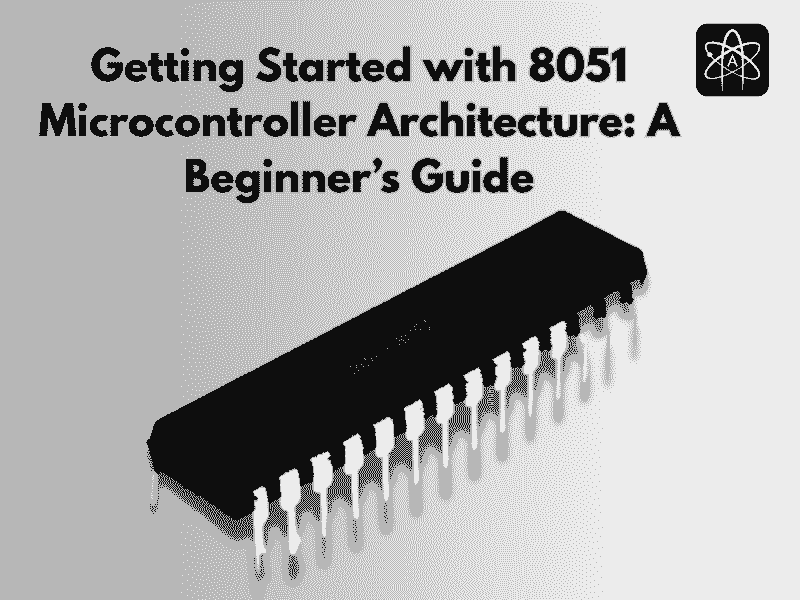The 8051 microcontroller, or you can say the Intel MCS-51 family microcontrollers, was developed in 1980-1981 by the well-known Intel. It is an 8-bit microcontroller, which is mainly designed for embedded systems, and this was something that was widely used heavily in many devices back in the 1980s. 8051 microcontroller architecture is popular in educational and industrial areas because of its simple design and the feature of wide use. The 8051 microcontroller architecture is a Harvard architecture, which helps keep data memory and program memory separate. This architecture helps them work faster, and it comes with two 16-bit address buses and an 8-bit data bus to handle the data and program.
8051 Microcontroller Memory Organisation
- On Chip ROM: The original type of 8051 has the capacity of 4 KB of program memory to store all the code.
- External Memory: This 8051 can connect to more than 64 KB of extra data and program memory using the separate address buses.
- On Chip Ram: This 8051 microcontroller memory organisation comes with 128 bytes of data RAM for daily use and also with 128 bytes for the special function registers that help in controlling different parts of the microcontroller.
8051 Microcontroller Architecture CPU Components
- ALU and Accumulator: The 8051 microcontroller architecture has its 8-bit ALU, which helps in doing the logic and arithmetic operations. The accumulator in it is the main register used for the tasks.
- B Register: This works with the accumulator part for division and multiplication operations.
- Stack Pointer: It’s an 8-bit register that helps in managing the stack inside RAM.
- Program Counter: It’s a 16-bit register that helps in keeping track of the next instruction’s address, the 8051 microcontroller timers and counters.
- Register Banks: This 8051 has 4 banks, each with R0-R7 registers, and it allows quick switching between tasks.
- Program Status Word: It’s an 8-bit register with bits and flags to select one from 4 register banks.
- Data Pointer: It’s another 16-bit register used for external memory, split into DPH and DPL.
8051 Microcontroller Architecture Core Registers and Functions
I/O Parts: The I/O parts have four output/input ports, which gives a total of 32 pins. This port helps in connecting users to external devices.
Timers/Counters: 8051 microcontroller timers and counters include the 16-bit timers. They support different models like the Splid model and auto reload, which are controlled by TCON and TMOD registers.
Role of the 8051 in AI Applications
We discussed the technical terms of the 8051 microcontroller, but we can’t forget to know how the role of the 8051 in AI applications works because AI holds an important part in today’s world. The 8051 microcontroller architecture is a traditional one, but it still holds value in the AI-powered industry. In many areas, this gets used as a supporting controller in devices that integrate sensors and communication modules with AI algorithms, which are running on powerful processors. Now, for example, in IoT-based AI systems, this can work for handling the low-level tasks like collecting the data and device control. The simplicity and the lower power consumption of it make it a good choice for many AI-driven smart devices.
8051 Microcontroller Advantages and Limitations
Low Power & Variants: The modern version of the 8051 microcontroller architecture includes flash memory, power-saving modes, and watchdog timers. It also supports the extra features like SPI, RTC, and CAN for the advanced applications.
RAM & Boolean Processors: The next 8051 microcontroller advantages and limitations include working on registers, single bits in RAM, and ports. This helps in controlling the applications.
8051 Microcontroller Architecture in Modern Systems
The 8051 Microcontroller Architecture is still getting used. Widely because it’s well known, simple to use, reliable, and also affordable. It gets used in applications of 8051 microcontroller in embedded systems and in many industries. The common applications of it are medical devices, consumer electronics, cars, and some automation systems. Its use of it is a bit less now, but it’s not finished; from the start, it always plays an internal role to complete the simple needs in affordable ranges.



